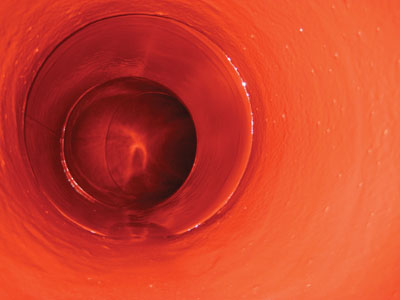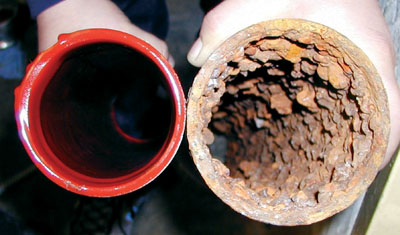Rehabilitating your pipes doesn’t mean destruction.
Retail facility managers and property owners are always concerned about the upkeep of their buildings, green trends and the safety of their visitors. It is no wonder why owners are always taking the next step to upgrade to energy-efficient lighting and restrooms while keeping the building updated and modern.
On June 23, 2012, a mall collapsed in Elliot Lake, Ontario, killing two and injuring more than 20 people. Several mall workers complained about the mall’s maintenance issues, including leaking ceilings. In other reports, there were leaks that had damaged the building’s fire proofing.
Behind the finished walls, underneath the marble floors and below the landscaped gardens, you can find something that is aging and often forgotten about. Pipe systems need updating too, but the traditional process to dig up and replace pipes is time consuming and costly. This is why many property managers are choosing a non-invasive solution to fix their pipe problems: pipe lining.
With pipe lining, the green impact and proactive measures are endless. Old drain pipes are being rehabilitated back to life without creating landfill waste or the need for new dirt, concrete and other aggregates. Lining companies can also license these lining technologies and provide cost-effective solutions to property managers and homeowners. The truth is that pipes only have a certain lifespan before problems occur, so many retail facility managers and property owners are also taking the proactive approach to rehab their pipes before a major problem occurs.
 The Repipe Alternative
The Repipe Alternative
A traditional repipe can consist of demolition to flooring, ceilings and parking lots. With trenchless pipe lining, pipes no longer have to be dug up and replaced. There is no need for downtime in your facility or the need to remove concrete foundations, walls and costly renovations.
Trenchless pipe lining technologies have been around for decades, passing the test of time. In the late 1980s, all of the U.S. Navy’s Aircraft Carriers’ collection, hold and transfer pipe systems were lined with blown-in epoxy coating.
These in situ pipe repair techniques can offer cost savings of up to 60% and time savings of up to 30% when compared to traditional pipe repair methods.
Success Story
When a lateral sewer line of 4-inch cast iron from 1961 was failing underneath the middle of a Barnes & Noble sales floor to a Starbucks, Grossmont Shopping Center in La Mesa, California, knew they had to fix their pipes, but did not want to disrupt tenants and shoppers. They chose the rehabilitation method over traditional methods of replacing to avoid the inconvenience.
 The corrosion of the cast iron resulted in chronic failure, including clogging and multiple backups that required a plumber to clear. After a camera inspection, it was clear that the bottom of the pipe had a large hole.
The corrosion of the cast iron resulted in chronic failure, including clogging and multiple backups that required a plumber to clear. After a camera inspection, it was clear that the bottom of the pipe had a large hole.
During the pipe rehabilitation process, the pipes were cleared of interior corrosion, bringing them back to original size. Once complete, the pipes were retrofitted with a patented process that pulls a seamless structural epoxy liner into place to extend the useful life of the pipes, without causing destruction.
In order to avoid inconvenience, the work was performed after mall hours, with the trenchless technology that did not require digging through the floors and foundation.
“As opposed to using traditional methods of replacing the failed portion of pipe and inconveniencing our tenant, we chose to line the interior of the pipe with an epoxy,” says Mike Hanson, general manager of Grossmont Shopping Center.
Any Pipe, Anywhere
Pipe lining is available to line virtually any pipe, anywhere, including underground and within buildings. Mechanical systems such as fire suppression, HVAC, industrial pressure systems and more can use air induced epoxy coatings. Vertical drain stacks, roof drains, storm systems and sanitary drain pipes can also be restored with an epoxy-filled liner, creating a new pipe within the existing pipe.
The process for the pipe rehabilitation project begins with mapping the internal plumbing system and camera inspection of drain and sewer lines. Drain pipes with diameters of 3/4-inch to 12 inches, as well as larger pipe diameters, use a patented pull-in-place process.
A plan is then implemented to minimize disruption and afford the most efficient timeline for work completion. After the drain lines are cleaned with cutting tools to bring the pipe back to original diameter, an inflatable bladder is inserted into the pipe with a felt liner that is saturated in epoxy. The bladder is expanded, adhering to the inside of the pipe walls. When the epoxy has cured (hardened), a new seamless protective pipe is formed within the existing pipe.
 This lining method provides the ability to line multiple 45° and 90° angles, as well as the option of lining specific sections of pipe without lining the entire length. Once complete, a final leak test and camera inspection is performed and the system is now a smooth, jointless pipe within the existing host pipe.
This lining method provides the ability to line multiple 45° and 90° angles, as well as the option of lining specific sections of pipe without lining the entire length. Once complete, a final leak test and camera inspection is performed and the system is now a smooth, jointless pipe within the existing host pipe.
Now you may be left wondering: “What about my potable and mechanical systems?” There is also a patented unique solution to protect against pipe corrosion, eliminate leaks and prevent further problems.
Potable and mechanical systems that range from 1/2-inch to 12 inches in diameter can be coated with a blown-in process. This solution is used to rehabilitate pipes or as a preventative measure.
During this process, the pipes are first inspected to determine the problematic areas and pipe dimensions. Common problems discovered during inspection and assessments are pinhole leaks, breaks, corrosion and buildup. Certain types of pipe systems will have commonly noted issues. For example, galvanized steel potable water piping is more likely to have buildup of metals where copper water pipes commonly experience pinhole leaks.
After inspection, pipes are dried with heated, compressed air and an agent is blown through the pipes to remove rust and corrosion. Epoxy is then blown through the pipes, creating a thin and smooth barrier between the original pipe and the water flowing through it. This helps to prevent lead from leeching into the water and corrosion buildup.
These exact processes are also being used as a proactive approach to extend the useful life of pipe systems before major failure. This is why pipe lining technology is used by the most innovative and successful companies across the globe. With unique, versatile technology, virtually any pipe, anywhere, in any property can be rehabilitated.
— Alyscia Sutch is the marketing coordinator for Nu Flow Technologies licensing and manufacturing facility. Nu Flow Technologies manufactures, installs and distributes green repipe alternatives and no-dig solutions, including epoxy coatings for potable water lines and mechanical systems and structural liners for drain lines.
